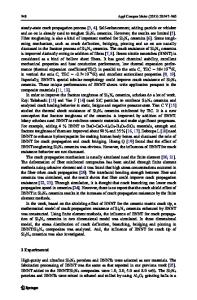Energetics of cubic Si 3 N 4
- PDF / 81,288 Bytes
- 4 Pages / 612 x 792 pts (letter) Page_size
- 10 Downloads / 351 Views
Toshimori Sekine National Institute for Materials Science, Tsukuba, Ibaraki 305-0044, Japan (Received 23 February 2005; accepted 7 June 2005)
High-temperature oxide melt drop solution calorimetry was used to study the energetics of formation of cubic silicon nitride prepared at high pressure. The standard enthalpy of formation of c-Si3N4 is −776.3 ± 9.5 kJ/mol. The calorimetric measurement of Si3N4 in 3Na2O·4MoO3 solvent was validated by comparing the enthalpy of formation for –Si3N4 with previous work using alkali borate solvent. The enthalpy of transformation from – to c-Si3N4 is 80.2 ± 9.6 kJ/mol. This value appears consistent with the observed synthesis conditions, which do not represent reversed equilibrium reactions.
I. INTRODUCTION
II. EXPERIMENTAL
Group IV nitrides present great technological interest for their advanced mechanical, electronic, and thermal properties.1,2 In addition to the two polymorphs known at atmospheric pressure, ␣ and , a third cubic form (c-Si3N4) with a spinel structure has been synthesized recently in laser-heated diamond anvil cell (DAC) and multi-anvil (MA) apparatus at pressures above 12 GPa.3,4 Compared to DAC and MA experiments, shock wave experiments provide a much shorter time (∼ s) of compression and can treat more samples.5,6 This is particularly important for mass production of cubic nitrides for industrial applications. First-principles calculations7,8 predict c-Si3N4 to be a superhard material and a semiconductor due to its possible smaller band gap. Determining energetics of formation of cubic nitrides is an important step toward understanding phase stability and materials compatibility, and why phases form. A recent calorimetric study9 of the ␣– and –Si3N4 polymorphs established that there is essentially no difference in enthalpy of formation between them. The driving force behind the transformation of ␣– to –Si3N4 probably lies in the transfer of impurities from solid solution in ␣ to separate SiO2 and SiC phases coexisting with . In the current study, we carried out drop solution calorimetry experiments to measure the standard enthalpy of formation of c-Si3N4, and to evaluate the enthalpy of transformation from – to c-Si3N4.
A. Source of samples and chemical analysis
a)
Present address: Intel Corporation, 2501 NW 229th St, Hillsboro, OR 97124. b) Address all correspondence to this author. e-mail: [email protected] DOI: 10.1557/JMR.2006.0033 J. Mater. Res., Vol. 21, No. 1, Jan 2006
http://journals.cambridge.org
Downloaded: 05 Apr 2015
c-Si3N4 (XRD patterns shown in Fig. 1) was prepared using shock recovery experiments with details given elsewhere.10 The starting material was a pure powder of –Si3N4. Metal flyer plates of copper impacted samples in containers made of copper. The shock pressure was about 40 GPa. The container was cut open to remove the sample. The powder obtained was immersed in a nitric acid solution to remove copper pressure media. By using hydrofluoric acid at high temperatures, the low-pressure Si3N4 phase and an oxygen-rich
Data Loading...











